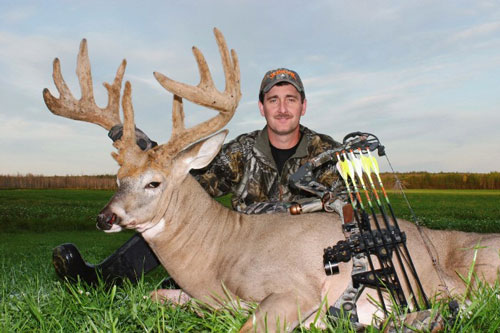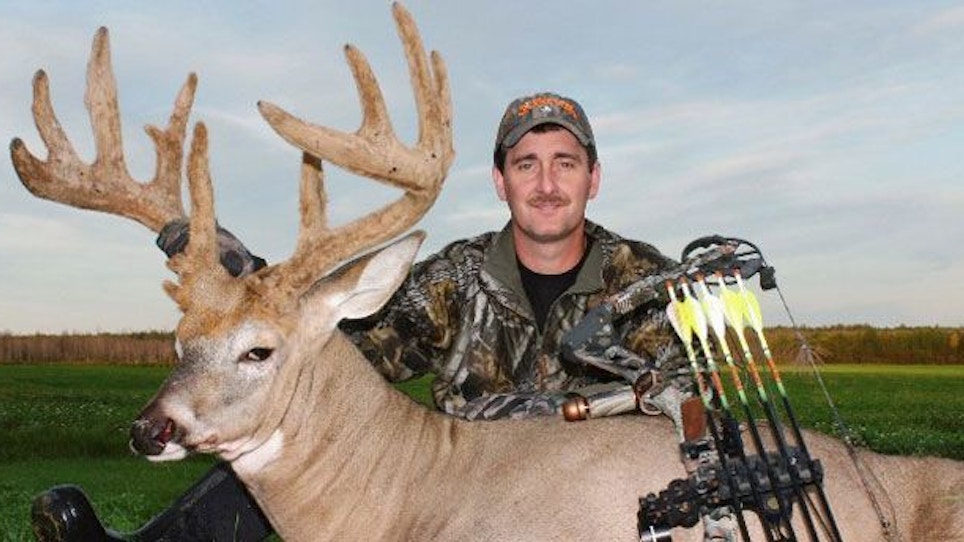 Bowhunting trends come and go—deer slams, turkey slams, even Super Slams (until blue-collar working stiffs discovered this was the territory of only the well-heeled). Everyone seems to have a lofty goal these days instead of simply bowhunting for simple fun. I admit to having fallen into this mode myself, normally taking to the field with an agenda other than pure relaxation in mind.
Bowhunting trends come and go—deer slams, turkey slams, even Super Slams (until blue-collar working stiffs discovered this was the territory of only the well-heeled). Everyone seems to have a lofty goal these days instead of simply bowhunting for simple fun. I admit to having fallen into this mode myself, normally taking to the field with an agenda other than pure relaxation in mind.
One of the latest trends is to somehow arrow a trophy whitetail buck still wearing velvet. In most whitetail strongholds this is statistically or, more accurately, physically impossible. Simple fact is, most Eastern and Midwestern whitetail seasons, even the earliest archery-only dates, kick off well after bucks have shed velvet to reveal hard-polished antlers for another season.
Even when including those states with the earliest archery opening dates of August and September, tagging a whitetail buck wearing velvet antlers remains a 50-50 proposition. Velvet stripping is triggered by the changing photo period striking optic nerves, initiating a spike in the testosterone required for final antler mineralization. The window of opportunity varies just like any biological function, occurring earlier in some individuals and regions than others.
After giving the situation much thought, these are my top opportunity picks for taking bucks in velvet. I base them on a combination of favorable season openers with a reasonable chance at actually patterning a trophy whitetail during these early dates.
Northeastern Washington
With archery deer seasons starting the first of September, northeastern Washington (www.wdfw.wa.gov) gives bowhunters a good shot at collecting a velvet-antlered whitetail. The best bets are found on public lands north of Spokane all the way to the British Columbia border. This is mixed boreal forest with private agricultural habitat of wheat, oats, barley, peas, and garbanzo beans (a whitetail favorite) at its edges. The best bet for early success is scouting for a buck feeding in such a field and applying standard early-season ambush techniques. This includes hunting field edges only evenings to avoid spooking feeding deer still in morning. Or set up on an established trail well away from feed, catching bucks traveling deeper into cover as heat rises. Washington allows deer baiting, making this a viable option in public National Forest areas, where planted alfalfa, corn, or peas bring deer out of the woodwork. The key is to find a site receiving minimal disturbance from other hunters and non-hunting hikers. Trophy quality can prove exceptional.
Alberta
Alberta’s (www.albertaregulations.ca) August 25 archery-only opening day makes it a prime pick for collecting a velvet-wearing trophy buck. Areas such as the Edmonton and Calgary Bow-Only Zones, and similar agricultural areas to the west and south, provide classic farm country settings where deer also grow world-class antlers. Most bowhunting is conducted from stands at the edges of alfalfa fields, though bowhunters should not be intimidated by the prospect of spot & stalk ploys in more broken country where the approach can prove highly profitable.
Northeastern Wyoming
Northeastern Wyoming’s (www.gf.state.wy.us) Devil’s Tower region and outlying counties have become a go-to destination for the velvet-obsessed, offering a September 1 archery start date that makes this a high-odds proposition. Booner bucks are rare, but plenty of P&Y-quality bucks are taken each season. And since baiting is perfectly legal, luring a trophy buck within range is made easier with preparation (especially during drier years), though many choose to situate a stand at the edge of private agricultural fields found along the area’s major rivers. Arranging trespass can prove tricky, as area outfitters have mostly secured the best properties.
Kentucky
Kentucky (www.fw.ky.gov) has emerged as the up-and-coming trophy whitetail state, supplying a high number of Boone & Crockett bucks in recent years. With a September 4 opening day for bowhunters, the chances of velvet antlers are fair to good. Early seasons are tough here due to an overabundance of prime habitat, but smart hunters focus on scouting concentrations of acorn-bearing white or red oaks to find success during these early seasons.
South Carolina
South Carolina (www.dnr.sc.gov) has the earliest whitetail seasons in North America, “Low Country” areas (Zones 3 and 5) allow hunters to begin August 15. This makes velvet bucks nearly assured, though bowhunting them is tough duty in Deep South jungle, and the frequency of trophy bucks can’t match other trophy whitetail ground, though big bucks are certainly available.






